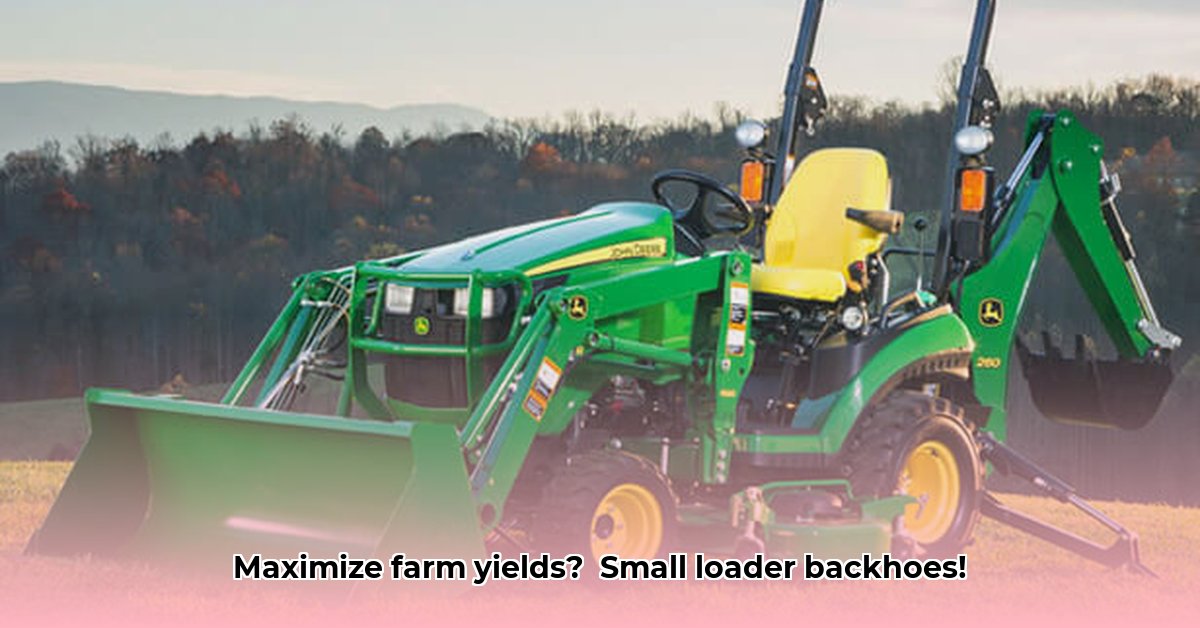
Small loader backhoe tractors are revolutionizing sustainable farming practices by offering increased efficiency and versatility. This comprehensive guide explores the market, key features, sustainability considerations, and a practical buying process to help you make an informed decision. For more information on John Deere models, check out this helpful resource: John Deere Backhoes.
Navigating the Market for Compact Tractor Backhoes: A Market Overview
The market for compact tractor backhoes is diverse, with leading manufacturers like Kubota, John Deere, and Massey Ferguson offering a wide range of models. Prices range from approximately $15,000 to over $40,000, depending on size, horsepower, and features. This variety ensures options exist for farms of all sizes and budgets. Choosing the right model hinges on carefully assessing your farm's specific needs and operational scale. What are your most critical tasks? Prioritizing these tasks informs your model selection.
Essential Features and Their Impact on Sustainable Farming
Compact tractor backhoes offer several features designed to enhance efficiency and minimize environmental impact:
Hydrostatic Transmissions: These offer smooth, precise control, reducing fuel waste and enhancing maneuverability in challenging terrain. (Think of it like a continuously variable transmission in a car, allowing for smoother and more efficient power delivery.)
Power Steering: Power steering significantly reduces operator fatigue, increasing productivity and safety during long workdays. (No more strained muscles after a long day of work!)
Wet Disc Brakes: Wet disc brakes provide superior stopping power, enhancing safety and operator confidence. (These brakes are more effective and have a longer lifespan than dry disc brakes.)
The versatility of these machines extends beyond digging. They efficiently handle plowing, post-hole digging, trenching, and material handling, reducing reliance on multiple pieces of equipment. This multi-functionality enhances overall efficiency and lowers operational costs. How many different tasks could your farm benefit from?
Sustainability: A Holistic Perspective
Sustainable farming requires considering the entire lifecycle of equipment. Here's a breakdown of key sustainability aspects:
Fuel Efficiency: Fuel-efficient models directly reduce operating costs and decrease your carbon footprint. Exploring alternative fuels like biodiesel, where available and suitable for your machine, further minimizes environmental impact. Does your farm's location offer access to and legality for alternative fuels?
Environmental Impact of Manufacturing & Disposal: Choose responsibly manufactured machines and plan for environmentally sound disposal at the end of the machine's life cycle. Proper recycling or responsible disposal minimizes the environmental impact of your investment. Where are your local recycling options?
Soil Compaction: Excessive soil compaction diminishes crop yields. Use appropriate operating techniques and tire pressures to mitigate this. Experts recommend rotating fields to allow soil recovery and recovery. What techniques do you use to minimize soil compaction?
Economic Viability: A thorough return on investment (ROI) analysis is crucial. Consider increased efficiency, expanded services, and cost savings across equipment needs to determine profitability. A detailed financial projection—taking depreciation, maintenance, and potential additional income into account—is indispensable in determining whether this investment is viable for your operation.
A Practical Buying Guide: Making the Right Choice
Selecting the appropriate compact tractor backhoe involves careful consideration of various factors:
Farm size and Type: Match the machine's capacity to your farm's scale and workload. Are your fields large and open, or small and obstructed?
Soil Conditions: Soil type dictates the required power and traction. Heavy clay soil needs more powerful machines than lighter soils. What is the composition of your farm's soil?
Budget: Establish a realistic budget encompassing the purchase price, financing, maintenance, and potential repairs. What financing options are available to you?
Maintenance and Support: Reliable access to parts and qualified service technicians is vital. Choose a brand with a well-established service network. Is there a reliable dealer close to your farm?
Risk Assessment: Consider potential risks, such as high initial cost, fuel consumption, soil compaction, and maintenance expenses. Develop mitigation strategies to address these risks before investing.
Return on Investment (ROI) and Long-Term Sustainability
While the initial investment is substantial, the potential ROI through increased efficiency and diversified services is significant. A comprehensive ROI calculation should consider all revenue streams and expenses over the lifespan of the equipment.
Simplified ROI Calculation Example:
A $30,000 tractor generating an extra $10,000 annual profit for five years results in a 67% ROI (($50,000 - $30,000) / $30,000). This is a simplified illustration. A comprehensive analysis must factor in all expenses and potential income streams.
Conclusion: Investing in a Sustainable Future
Compact tractor backhoes present a significant opportunity to boost efficiency and sustainability in farming. Informed decision-making—based on thorough research, planning, and a comprehensive cost-benefit analysis—is imperative for a successful and environmentally conscious investment. Careful consideration of features, sustainability concerns, and financial implications ensures your success and contributes to a long-term vision for a prosperous and environmentally friendly farm.